PinotFile: 12.10 November 11, 2020
|
Are There Any Under $30 2018 Domestic Pinot Noirs Worth Drinking? 30 Prospects Priced Less Than $30
Great domestic Pinot Noir does not come cheap these days. Do you prefer double or triple digits? Here are some prices of recently released ultra-premium California Pinot Noir wines: 2017 Calera Jensen Vineyard Mt. Harlan Pinot Noir $100, 2017 Arista Harper’s Rest Russian River Valley Pinot Noir $110, 2018 Aubert CIX Sonoma Coast Pinot Noir $110, 2018 Rhys Vineyards Swan Terrace Santa Cruz Mountains Pinot Noir $119, 2017 Goldeneye Ten Degrees Anderson Valley Pinot Noir $130, 2017 L’Usine Annapolis Ridge Vineyard Sonoma Coast Pinot Noir $150, 2017 Cirq Russian River Valley Pinot Noir $150, and 2017 Kosta Browne Treehouse Vineyard Russian River Valley Pinot Noir $200. Examples of recently released ultra-premium Oregon Pinot Noir wines: 2017 Adelsheim Bryan Creek Chehalem Mountains Pinot Noir $100, 2017 Ponzi Vineyards Avellana Chehalem Mountains Pinot Noir $105, 2018 Beaux Frères The Upper Terrace Ribbon Ridge Pinot Noir $110, 2018 OO Wines Richard Hermann Cuvée Willamette Valley Pinot Noir $125, 2018 Archery Summit Summit Vineyard Dundee Hills Pinot Noir $125, 2014 The Eyrie Vineyards South Block Reserve Dundee Hills Pinot Noir $180, and 2016 Domaine Serene Monogram Willamette Valley Pinot Noir $295. Of course, these exalted prices pale in comparison to Napa Valley prestige releases such as 2016 Shafer Stags Leap District Hillside Select ($310), 2017 Opus One ($365) and 2015 Abreu Thorevilos ($525). Scarecrow, Harlan Estate and Screaming Eagle Cabernet Sauvignon wines can approach $1000 a bottle upon release. In 2020, the economic environment is pinching many wine consumers, reminding me of the words of Tom Paxton’s song, ‘Bottle of Wine’: “Times getting rough I ain’t got enough To buy me a bottle of wine.” Forget about great, even very good or good Pinot Noir has often priced over $30 a bottle, so I set out to find some under $30 domestic Pinot Noir wines that are worth drinking.
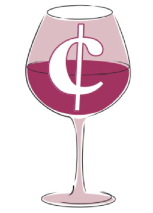 I chose to concentrate on the 2018 vintage because the growing seasons in both California and Oregon displayed nearly perfect growing conditions and the wines are currently widely available in the marketplace. There are still plenty of 2017 vintage Pinot Noirs available to shoppers and the 2019 vintage Pinot Noirs are just now making their appearance. Prices in the under $30 Pinot Noir category vary and a search of retailers on the internet (try wine-searcher.com) can reveal the best buy. I have included at least one source for each wine. Free shipping may be included as an inducement to buy at least 6 bottles. For this class of Pinot Noir wines, little information is provided on the labels as to the exact wine region(s) the grapes came from, the vineyard(s) sourced, who made the wine and the vinification methods. When the back label says, “Produced and Bottled By,” then by law, 75% or more of the wine in the bottle must have been made (fermented) by the producer listed on the stated address. More often, with less expensive wines, the back label may say, “Vinted and Bottled By,” in which case the winery on the label may have very little to do with making the wine at the stated address, or “Cellared and Bottled By,” in which case the wine was only aged or cellared by the depicted winery until bottling. In many cases, only the name of the “phantom winery” that may have sourced bulk or declassified wine from any number of producers and slapped a label on the bottle is identified. The consumer has no way to know whether a “Pinot Noir” was made from 100% Pinot Noir grapes. The likelihood is higher in Pinot Noir from Oregon where if the label says “Willamette Valley,” at least 90% of the grapes must be Pinot Noir. California adheres to the federal standard that only requires 75% of the wine to be Pinot Noir. A resulting wine that is not 100% Pinot Noir can be a disappointing reflection of what Pinot Noir should be. I tried to pick a representative group of wines. It is clear to me that there are under $30 wines that are worth drinking and worth searching out. Look for “Produced and Bottled by” on the back label since these usually represent a more reliable quality wine. The 2018 Sean Minor Sonoma Coast Pinot Noir offered the best bang for the buck and the 2018 Cristom Mt. Jefferson Eola-Amity Hills Pinot Noir edged out California’s 2018 Morgan Twelve Clones Santa Lucia Highlands Pinot Noir and Oregon’s 2018 Evesham Wood La Grive Bleue Eola-Amity Hills Pinot Noir for the sweepstakes. If you, the reader, come across a great domestic Pinot Noir priced under $30 that is not included here, let me know and I will pass it on to other readers in the next issue of the PinotFile.
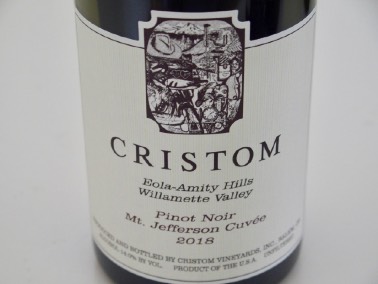 2018 Cristom Mt. Jefferson Cuvée Eola-Amity Hills Willamette Valley Pinot Noir 14.0% alc., 10,000 cases, $29.95 (K&L Wines, San Francisco, CA). Produced and bottled by Cristom Vineyards, Inc., Salem, OR. Whole cluster and native yeast fermented. Vineyards farmed Biodynamically and Certified Sustainable. · Terrific when tasted after two days from a previously opening and re-corked bottle indicating not only short-term but long-term enjoyability. Heads and shoulders above anything else in this under $30 price category. Score: 93
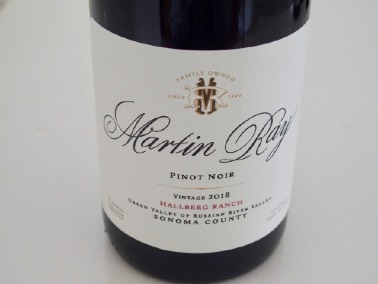 2018 Martin Ray Hallberg Ranch Green Valley of Russian River Valley Pinot Noir 14.5% alc., 300 cases, $27.50 (Wine Slash - original SRP $45). Produced and bottled by Martin Ray Winery, Santa Rosa, CA. Best of Class, Double Gold 2020 Sonoma County Harvest Fair. Aged 12 months in new French oak barrels. · Dark garnet color in the glass. Pleasing aromas of black cherry cola, dark red rose petal and a hint of soap. The enchanting velvety texture is alcohol driven in this mid-weight styled wine offering charming black cherry and spice flavors. Impressive fruit presence and pedigree with submerged tannins. My only nit is the slightest sense of alcoholic warmth. Score: 92
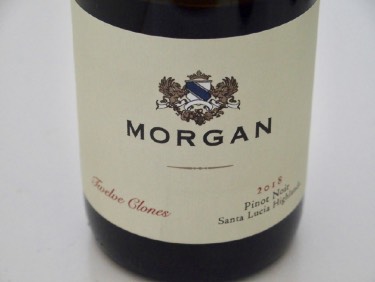 2018 Morgan Twelve Clones Santa Lucia Highlands Pinot Noir 14.3% alc., pH 3.56, TA 0.60, $29.95 (SRP is $35 but discounted by some retailers such as K&L Wines, San Francisco). Produced and bottled by Morgan Winery, Salinas, CA. A blend of grapes from Double L (62%), Rosella’s, Boekenoogen, KW and Tondre vineyards. 100% destemmed, native and cultured yeast fermentation in small, open-top tanks. Over 12 clones. Aged 9 months in French oak barrels, 35% new. · Moderately light garnet color in the glass. Enticing aromas of earthkissed black cherry and spice. Plentiful ripe black cherry and blackberry fruit flavors in a mid-weight plus, exuberant, fruit-driven style with a good supportive acid vibe. A underlying earthiness adds interest. Score: 92
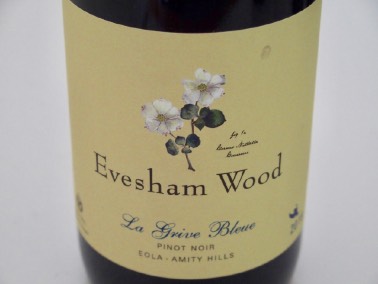 2018 Evesham Wood La Grive Bleue Eola-Amity Hills Willamette Valley Pinot Noir 13.0% alc., $26 (Vinopolis, Portland, OR). Grown, produced and bottled by Evesham Wood Vineyard & Winery, Inc., Salem, OR.. Made from organic grapes grown on non-irrigated vines. · Moderate garnet color in the glass. Aromas of red cherry and berry and damp mulch lead off. Very bright and fresh in a mid-weight style offering a mix of juicy red fruits framed by compatible tannins. Finishes very long with a lip-smacking cherry goodness. This wine overdelivers for the price. Score: 91
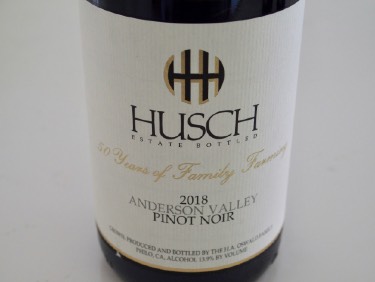 2018 Husch Anderson Valley Pinot Noir 13.9% alc., $21.99 (K&L Wines, San Francisco, CA). Grown, produced and bottled by H.A. Oswald Family, Philo, CA. · Moderately light garnet color in the glass. Aromas of red pie cherries, spice, loamy earth and oak. Energetic cherry, strawberry and dried herb flavors greet the palate and proceed to some length of finish. Beautifully balanced, with merged tannins and juicy acidity. This wine grows in appeal over time in the glass. Score: 91
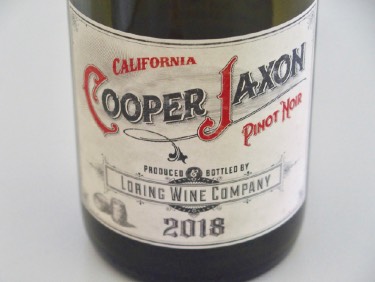 2018 Loring Wine Company Cooper Jaxon Santa Barbara County Pinot Noir 14.3% alc., 800 cases, $29, screw cap (winery mailing list). Produced and Bottled by Loring Wine Company, Lompoc, CA. The 2019 vintage (also $29) has just been released. A multi-vineyard blend that includes multiple Dijon clones. Aged 10 months in French oak barrels, 15% new. · Moderate garnet color in the glass. Instant pleasure in the glass with fresh aromas and flavors of black cherry, black raspberry and spice invigorated with uplifting acidity and moderated by gentle tannins. Everything is working in harmony in this immensely appealing value-priced offering. This is the perfect everyday, go-to Pinot Noir. Score: 91
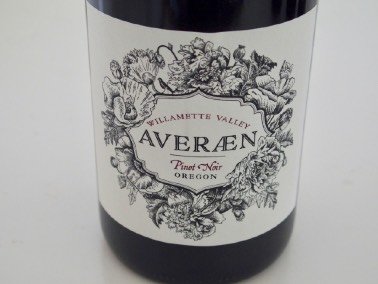 2018 Averaen Willamette Valley Pinot Noir 14.0% alc., pH 3.65, TA 0.675, $17.99 (Bottle Barn, Santa Rosa, CA). Produced and bottled by Averaen Wines, Dundee, OR. The Oregon arm of Banshee Wines that originated in Sonoma County. This wine is sourced from multiple vineyards throughout the Willamette Valley. · Moderate garnet color in the glass. Lovely aromas of black cherry, rose petal, peat and earthy flora. Plenty of black cherry driven mid palate intensity with subtle oak backing and gently firm and focused tannins. The satiny texture entices as does the finish that is noticeably persistent. Score: 90
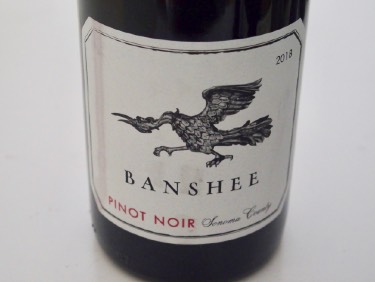 2018 Banshee Sonoma County Pinot Noir 13.9% alc., $19.99 (Total Wine). Vinted and Bottled by Banshee Wines, Sonoma, CA. · Moderately light garnet color in the glass. Delicate but pleasing aromas of red cherry and berry with a touch of spice. Light to mid-weight and elegant in style, offering flavors of red cherry and red raspberry framed by downy tannins. A very solid offering with admirable harmony. Score: 90
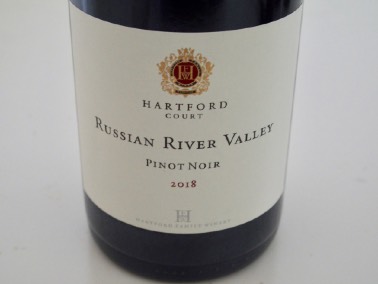 2018 Hartford Court Russian River Valley Pinot Noir 14.5% alc., $25 (Wine Slash). Vinted and bottled by Hartford Family winery, Santa Rosa, CA. · Moderately dark garnet color in the glass. Deep aromas of black cherry and floral perfume. Mid-weight flavors of boysenberry and black raspberry create intense mid-palate joy and finishing with modest power. Sleek and polished, with subtle oak enhancement. Alcohol is well-hidden. Score: 90
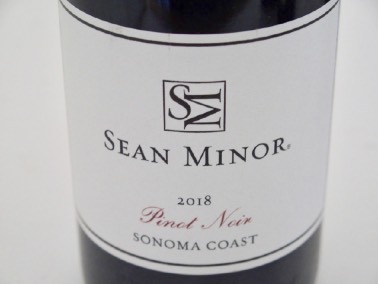 2018 Sean Minor Sonoma Coast Pinot Noir 13.5% alc., $14.49 (Bottle Barn, Santa Rosa). Vinted and bottled by Sean Minor, American Canyon, Napa County, CA. · Moderately light garnet color in the glass. Very engaging scent of cherry and baking spices. Delicious mid-weight core of fresh Bing cherry fruit goodness along with a touch of cola and spice. Very accommodating balance with some finishing power and length. No oak in sight. A fantastic value. Score: 90
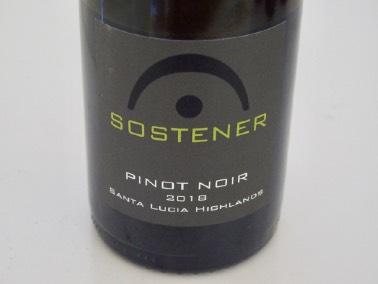 2018 Sostener Santa Lucia Highlands Pinot Noir 13.9% alc., $11.98-$19.99 (Wine-Searcher). Produced from old vines at the McIntyre Estate Vineyard. · Moderately light garnet color in the glass. The nose slowly opens to reveal pleasing aromas of black cherry and allspice. Very polished, elegant and easygoing on the palate, featuring black cherry and strawberry flavors accompanied with a riff of spice. Good acid verve and sparse tannins make for juicy early enjoyment. My only nit would be a bit of shallowness on the mid palate and a modest finish. An excellent everyday Pinot Noir and a solid value in old vine Pinot Noir. Score: 90
2018 Angeline Vineyards Mendocino County Pinot Noir 13.9% alc., $16.99, screw cap (Total Wine). Vinted and bottled by Angeline, Santa Rosa, CA. · Moderately light garnet color in the glass. Aromas of cherry and underbrush lead to a red-fruited, mid-weight wine with a better finish than entry. Silky in texture, with friendly tannins and acidity. Score: 89
2018 Arterberry Maresh Dundee Hills Willamette Valley Pinot Noir 13.0% alc., $26 (Vinopolis, Portland, OR). Produced and bottled by Arterberry Maresh, Dundee, OR. · Moderately light garnet color in the glass. An array of aromas present upon opening including red cherry, dried herbs, seasoned oak and nori. Lighter weighted and elegantly composed, with the essence of red cherry and cranberry fruit flavors backed by gentle tannins. A good grip of acidity powers the well-spiced, red fruit finish. This wine’s shallow mid-palate is made up by the surge of fruit on the finish. Score: 89
2018 Balletto Russian River Valley Pinot Noir 14.0% alc., $19.99 (Bottle Barn, Santa Rosa, CA). Produced and bottled by Barlletto Vineyards, Santa Rosa, CA. · Moderately light garnet color in the glass. Assertive aromas of Bing cherry and exotic spices lead off. A solid, seamless wine, with the essence of black cherry and ripe strawberry showing presence without pronounced body. Minimal tannins make for easy drinking. The finish is quenching but without length. Score: 89
2018 Failla Willamette Valley Pinot Noir 14.1% alc., $24.95 (K&L Wines, San Francisco, CA). Produced and bottled by Ehren Jordan Wine Cellars, McMinnville, OR. · Moderately dark garnet color in the glass. Nicely perfumed with aromas of blackberry, cassis and vanilla. Robust in style with a lavish core of purple and black berry fruits framed by bold but matched tannins. Oak plies the background and appears in the lengthy, fruitladen finish. An exuberant California-styled Pinot Noir that flirts with over-ripeness. Score: 89
2018 Martin Ray Sonoma Coast Pinot Noir 13.8% alc., $14.99, screw cap (Bottle Barn, Santa Rosa, CA). Vinted and bottled by Martin Ray Winery, Santa Rosa, CA. · Moderately light garnet color in the glass. Deep aromas of dark cherry, cola and cardamom spice. A flood of well-ripened boysenberry, black raspberry and blackberry fruit flavors greet the palate. More richness and tannic backbone than most wines in this price category with the somewhat potent tannins evident on the long finish. Score: 89
2018 Olema Sonoma County Pinot Noir 14.2% alc., $19.99 (Total Wine) Cellared and bottled by Amici Cellars, American Canyon, Napa County, CA. · Moderately dark garnet color in the glass. Shy, but pleasant aromas of black fruits with a hint of oak. A mid-weight plus styled wine rich in blackberry and black raspberry fruits. Soft in the mouth with integrated tannins and overall good balance. Not complex in a fruit-driven style with some finish that is satisfying. This wine would appeal to those looking for more fruit abundance and ripeness. Score: 89
2018 The Four Graces Willamette Valley Pinot Noir 13.9% alc., $22.97 (Total Wine). Vinted and Bottled by The Four Graces Winery, McMinnville, OR. · Strikingly deep garnet color. Aromas of black cherry, rose petal and vanilla are accompanied by some volatile acidity (apple core) initially. Great harmony with plenty of luscious purple berry fruits that are very satisfying. A middleweight style with excellent harmony, restrained tannins and some finishing persistence. Score: 89
2018 Wrath EX Monterey Pinot Noir 14.1% alc., $27 (winery website). Produced and Bottled by Wrath Wines, Soledad, CA. · Light garnet color in the glass. Pleasing aromas of cherry and spice that fade a bit over time in the glass. Light in weight but very charming, offering an array of juicy red fruits framed by gossamer tannins. Easy to cozy up to. Pinot Noir unplugged. Score: 89
2018 Drew Mid-Elevation Mendocino Ridge Pinot Noir 13.4% alc. $29.99 (K&L Wines, San Francisco, CA). Produced and bottled by Drew Family Cellars, Elk, CA. · Moderate garnet color in the glass. Aromas of land and sea include pine forest, sap and nori. Perfumed red and black cherry flavors have a woodsy edge. Juicy and bright, with a satisfying acid underbelly and very modest tannins. Finishes with some persistent glory. Score: 88
2018 FEL Anderson Valley Pinot Noir 14.2% alc., $28 (Wine Slash). Produced and bottled by FEL Wines, Sonoma, CA. I have had better vintages of this wine. · Moderately dark garnet color in the glass. Aromas of black cherry, earthy flora and smoky oak lead to a mid-weight plus styled wine featuring a rush of bold, earthbound boysenberry and black raspberry fruit flavors. Some tannic astringency infuses the finish and there is the slightest awareness of alcoholic warmth. Score: 88
2018 Larkspur Dundee Oregon Pinot Noir 13.8% alc., $9.99 (Kroger and other markets with a 6-bottle purchase). 100% Pinot Noir. Produced by Larkspur Wine Company, Dundee, OR. · Moderately light garnet color in the glass. Welcoming aromas of black cherry and subtle oak spice. Silky in the mouth and very comfortable, with a core of black cherry fruit accented with a hint of spice. The tannins are well-proportioned, the oak is wellmannered, and the dry, lip-smacking finish has a little length. This wine will not lead to an epiphany but will work as a satisfying everyday quaff. Score: 88
2018 Scar of the Sea Santa Barbara County Pinot Noir 13.0% alc., $24.95 (K&L Wines, San Francisco, CA).. Produced and bottled by Scar of the Sea, Santa Maria, CA. · Light ruby red color in the glass. Aloof but pleasant aromas of red cherry, cranberry, rose petal and sandalwood. Very elegant in a light-weight style somewhat akin to a rosé featuring fresh and bright flavors of red cherry and berry with gossamer tannins and a touch of oak. Score: 88
2018 Blank Canvas California Pinot Noir 13.8% alc., $12.84 (Kroger supermarket). Vinted and bottled by American Wine Cellars, Napa, CA. · Moderately light garnet color in the glass. Aromas of cherry vanilla Coke lead off. Aims to please in a modest way with mid-weight flavors of red cherry and berry backed by good acidity and tame tannins. Short on the finish, with a compliment of oak in the background. Score: 87
2018 Flaneur Willamette Valley Pinot Noir 14.0% alc., $24.40, screw cap (Vinopolis, Portland, OR). Produced and bottled by Flaneur Wines, Carlton, OR. Native yeast fermentation. Aged in 5% new French oak barrels. · Moderate garnet color in the glass. The nose offers not particularly redeeming aromas of peppery spice, black cherry and underbrush. Better on the palate with middleweight flavors of dark red and black cherry. The tannins rise up noticeably on the modest finish. Score: 86
2018 Joyce Submarine Canyon Monterey Pinot Noir 13.2% alc., $19.95 (K&L Wines, San Francisco, CA). Produced and bottled by Joyce Vineyards LLC, Salinas, CA. · Moderate garnet color in the glass. The nose opens over time in the glass to reveal aromas of cherry, underbrush and toasty oak. Light to mid-weight in concentration, featuring red and black cherry fruits that offer good length on the mid palate but finish a bit flat and short. Silky in texture, with balanced tannins and noticeable but not overly-intrusive oak on the finish. Score: 86
2018 A. Viloria Sonoma Coast Pinot Noir 13.0% alc., 75 cases, $17.99 (Bottle Barn, Santa Rosa). Cellared and bottled by A. Viloria Winery, Santa Rosa, CA. · Light ruby red color in the glass. Reluctant aromas of red cherry, red current and maple syrup. Light in weight, with a woody and herbaceous vibe infusing the core of cherry and raspberry fruits. Crisp acidity powers the finish. Score: 85
2018 Firesteed Willamette Valley Pinot Noir 14.1%, $10.77, screw cap (Total Wine). Cellared and bottled by Firesteed Cellars, Hopland, CA . Grapes grown in Oregon. · Moderately light garnet color in the glass. Unusual aromas of oiled wood, red candy, balsam and dark red cherry. Light to mid-weight flavors of cherry and raspberry with a noticeable woody note. Easygoing but shallow, with tame tannins and a very modest finish. Score: 85
2018 1849 Wine Company Iris Sonoma Coast Pinot Noir 14.5% alc., $29.99 (Kroger and other supermarkets). Cellared and bottled by 1849 Wine Company, St. Helena, CA. Striking label that is part of the 1849 Contemporary Art Collection. Aged 10 months in new French and Hungarian oak barrels. · Moderate garnet color in the glass. Aromas of black cherry, dark berry and toasty oak lead off. The modest and silky tannins are folded into the mid-weight black cherry fruit core that is imprinted with oak. There is a burnt quality to this wine on both the nose and palate. Score: 85
2018 Talbott Logan Sleepy Hollow Vineyard Santa Lucia Highlands Pinot Noir 14.2% alc., $22.49, screw cap (Total Wine). Estate Grown, Produced and Bottled by Robert Talbott Vineyards, Salinas, CA. · Moderate garnet color in the glass. The nose reveals a very ripe fruit profile with oak-induced ash and cigar aromas. Oak dominates the wine’s flavor profile that is centered around a black cherry fruit core. Drinkable, but little redeeming value. Score: 85
Sun Break Wines: Unique Value-Priced Oregon Pinot NoirThis new Pinot Noir-focused winery in the Willamette Valley has a connection to Lumos Wine Company featured in the last issue of the PinotFile. David Patte, owner and winemaker for Sun Break Wines, wrote me to tell me that he worked in the cellar as an intern for Lumos and the other wineries at their co-op in McMinnville such as Domino IV and Native Flora. David also worked at the Lumos tasting room for four years. He was a long time follower of the Prince of Pinot website. In the inaugural vintage of 2018, David produced three wines from the Cortell-Rose Vineyard located in the Eola-Amity Hills across the road from Brooks Estate. He wanted Sun Break Wines to focus on one vineyard so he could obtain a variety of clones (five in this case) and vinify using three distinct styles: Colette is 100% destemmed, Marie-Paule is 50% de-stemmed, and Ariane is 100% whole cluster.
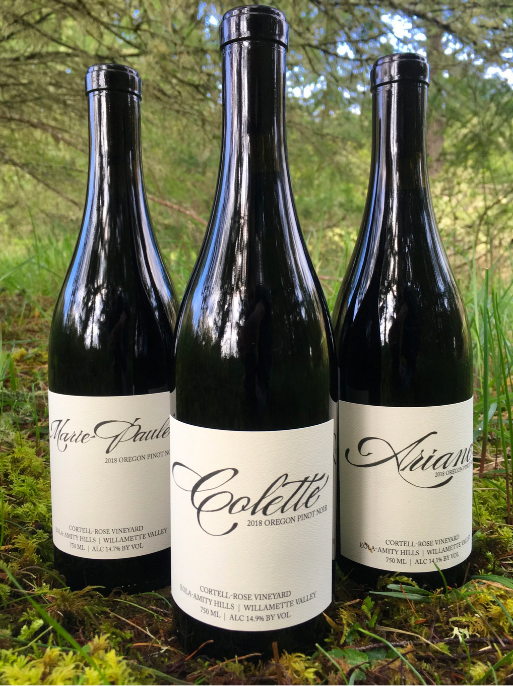 The vineyard is co-owned and managed with organic practices by Jessica Cortell who farms several top-tier organic vineyards such as Seven Springs, Medici and Antica Terra. Jessica chose this vineyard as her own for its location on volcanic Jory soils at 525’-680’ elevation. The three wines reflect the exceptionally warm and dry 2018 vintage and are bold, intense and ripe-fruited examples of Pinot Noir. At harvest, the grapes had a lower-than-average water content that increased the phenolic (fruit) concentration while also increasing the acidity ratio. David chose not to add water as many other winemakers did in 2018, instead he tempered the resulting high ABV of the wines with the high natural acidity. I found that the wines had the lavish fruit and acidity working in harmony and the relatively high ABV was well integrated. In other words, the wines drank like a Pinot Noir with lower ABV and did not beat down the palate with jammy fruit. The wines are all produced with no added sulfites, but cross-flow filtered to ensure stability and aging potential without spoilage. Some naturally-occurring sulfites may be present. The wines were produced and bottled by Sun Break Wines in Amity, Oregon. Best of all, each wine is priced at $29. Unfortunately, the small production and low price led those in the know to snap up these wines quickly and the Colette is sold out, the Ariane might be sold out by the time you read this, but the Marie-Paule is still available. More grape tonnage is planned for future vintages to increase production. The winery is a One Percent for the Planet member, donating one percent of all sales to environmental projects including projects that provide 22 tons of carbon offsets. David offers free wine and cider business and/or wine and cider production mentorship opportunities to black and brown colleagues, students, women and LGBTQ folks. Visit www.SunBreakWineCider.com for more information and to purchase the wines.
2018 Sun Break Wines Colette Eola-Amity Hills Willamette Valley Pinot Noir 14.9% alc., pH 3.39, TA 0.59, 76 cases, $29. Pommard, Wadenswil and Dijon 667 clones. 100% de-stemmed. No extended maceration. Aged 10 months in older French oak barrels. No sulfites added. No racking until assemblage prior to bottling. Cross flow filtered. · Dark garnet color in the glass. Very shy aromas of blackberry and black currant fruits. Midweight plus in style, offering a flood of purple and black berry fruits infused with a slight hint of oak in the background. Plush on the palate with great purity of flavor, showing unpretentious tannins and good brightness. The finish is modest but satisfying. Score: 90
2018 Sun Break Wines Marie-Paule Eola-Amity Hills Willamette Valley Pinot Noir 14.7% alc., pH 3.50, TA 0.61, 156 cases, $29. Pommard, Wadenswil and Dijon 114, 667 and 777 clones. 50% de-stemmed and 50% whole cluster. No extended maceration. Aged 16 months in older French oak barrels. No sulfites added. Racked once at assemblage prior to bottling. Cross flow filtered. · Moderately dark garnet color in the glass. Delicate aromas of blackberry, black currant and sweet tobacco. Well-endowed with lavish, dark fruits that offer more pop and finishing length than that found n the Colette bottling. There is a little more, but not intrusive, tannic spine evident. Score: 91
2018 Sun Break Wines Ariane Eola-Amity Hills Willamette Valley Pinot Noir 14.1% alc., pH 3.29, TA 0.67, 67 cases, $29. 100% Dijon clone 777. 100% whole cluster fermentation. Aged 16 months in older French oak barrels. No sulfites added. Racked once at assemblage. Cross flow filtered. · Dark garnet color in the glass. Alluring aromas of currant, blackberry, spice, sap and sous-bois. Very juicy and agreeable in a mid-weight style with charming fruits that cascade over the palate. The most tannin of the three 2018 Sun Break Pinot Noirs is evident, yet complimentary. This wine sports mpressive harmony with a very long, black grape-infused finish. Score: 93
Featured Winery: Beauregard VineyardsRyan Beauregard recently wrote to me about the challenges of 2020. He is a fourth-generation winegrower in the Santa Cruz Mountains who founded his winery in 2000 at the tender age of 25. Ryan developed a love for winegrowing at a young age, growing up on the Beauregard Ranch (the original vineyard purchased by his great-grandfather in 1949) playing among the vines as a child. Today, 105 vineyard acres under the Beauregard Vineyards label are maintained by Ryan’s father, Jim, supplying the grapes for the Beauregard Vineyards label. I first met Ryan years ago at Pinot Paradise in the Santa Cruz Mountains and have always admired his winemaking acumen.
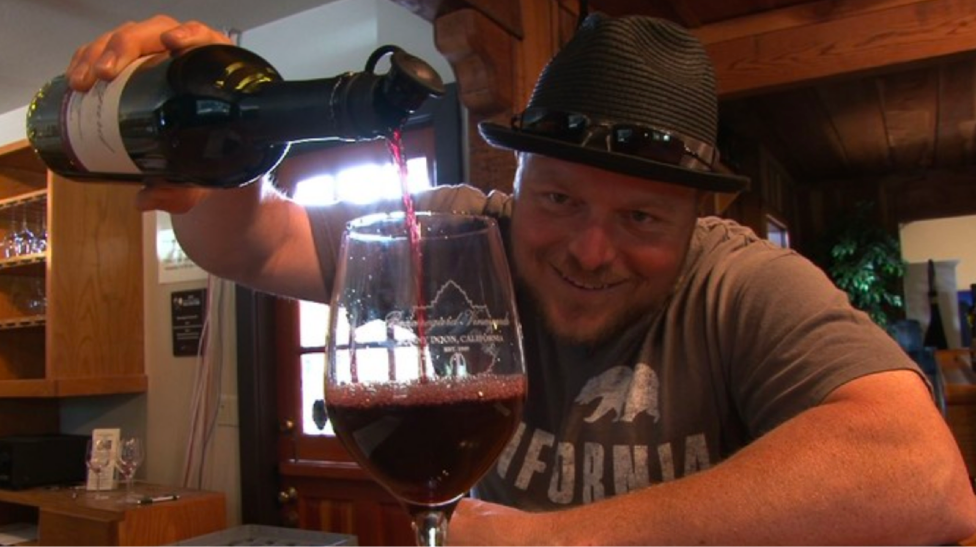 Here is what Ryan told me. “Here at Beauregard Vineyards I am feeling heaps of gratitude. The majority of our mountains have burned. The CZU Lightning Complex fire consumed 87,000 acres and came very close to our homes and winery. My gratitude stems from the fact that our family still has our homes and winery. Many of my close friends are displaced and the scars left behind in our community and natural landscape will take a generation to recover. Some of the reason that we still have our homes is that renegade fire brigades were formed in our community. There were many winery fermentation bins in the back of pickup trucks filled with water moving through the neighborhood putting out spot fires. Cal Fire was over taxed and could not get to us for four days. This is an experience I hope to never relive.” He also noted the following. “The crop of 2020 is a loss, and the outcome equates to a year’s loss of revenue in the future when we will feel the pain of the lost crop. In the grand scheme of things, however, our damage is minimal. So far this year we have been closed for three months due to COVID-19 and the fire. I am grateful that our customers supported us by purchasing so much wine online. I hope that the remainder of 2020 will bring us good news. As for me, I am looking forward to the moment I can fill the last barrel of the vintage, cover crop the vineyard and then leave on a distant vacation with my wife and daughters to reconnect with our children and reassure their young souls them that the world is not always this crazy.” I believe this heartfelt missive reflects the hardships that many in the wine industry are experiencing in 2020 as a result of COVID-19, the economic slowdown and the fires. The 2017 and 2018 Beauregard Vineyards Estate Pinot Noirs are reviewed here. The 2018 vintage was a picture perfect vintage and Ryan is proud of the resulting wines. In 2018, he elevated the quality of the barrels and allowed just a little more barrel time than in years past. The Beauregard Ranch sits at an elevation of 1,700-1,850 feet on a southwest-facing slope exposed to Monterey Bay influences. Four acres of Pinot Noir (Pommard, 667 and 115) are planted in well-draining sandy loam soil. Coast Grade Vineyard is located in Bonny Doon in the Ben Lomond Mountain region of the Santa Cruz Mountains. The 17-acre vineyard was planted in 2008 at an elevation of 1,238-1,350 feet on a southwestfacing slope. Sandy loam soils provide excellent drainage. Visit www.beauregardvineyards.com for more information and to purchase wines. A well-regarded tasting experience is available at the winery tasting room at 10 Pine Flat Road in the Bonny Doon area of Santa Cruz.
2017 Beauregard Vineyards Coast Grade Vineyard Santa Cruz Mountains Pinot Noir 12.7% alc., 500 cases, $60. Native yeast fermented. 15% whole cluster. Aged in 20% new French oak barrels. · Moderately dark garnet color in the glass. The nose offers an array of aromas including black cherry, forest floor, peppery spice and oak. Somewhat hardy in a mid-weight plus style, with flavors of black cherry and blackberry fruit, spice and seasoned oak. Soothing in texture, with integrated tannins and some, but not extraordinary length on the finish. Score: 91
2018 Beauregard Vineyards Coast Grade Vineyard Santa Cruz Mountains Pinot Noir 12.5%, 509 cases, $60. Native yeast fermented. 15% whole cluster. Aged in 20% new French oak barrels. · Moderate garnet color in the glass. The aromas of muddled dark fruits are slow to arrive and noticeably better when the wine was sampled the day after opening. A tad lighter in weight compared to the 2017 vintage, but the dark cherry and black raspberry fruit is more flavorful and charming. Elegant, with faint tannins, some finishing persistence and absent of any oak attribute. Score: 92
2017 Beauregard Vineyards Beauregard Ranch Santa Cruz Mountains Pinot Noir 13.5% alc., 410 cases, $60. Native yeast fermented. 15% whole cluster. Aged in 20% new French oak barrels. · Moderately light garnet color in the glass. Effusive aromas of red currant and cherry with a compliment of toasty oak. Brimming with succulent dark red fruits that fan out with impressive length on the finish. Freshness is driven by a lively acid spine and there is overall satisfying harmony. The oak is well-integrated and the finish goes on and on. Score: 93
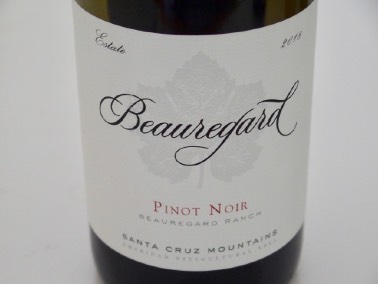 2018 Beauregard Vineyards Beauregard Ranch Santa Cruz Mountains Pinot Noir 12.5% alc., 410 cases, $60, Native yeast fermented. 15% whole cluster. Aged in 20% new French oak barrels. · Moderately light garnet color in the glass. Aromas of black cherry, black raspberry, sandalwood and sweet pipe smoke are slow to develop and are considerably more effusive when the wine was sampled a day after opening. Lavish black cherry, black raspberry and spice flavors greet the palate with expansive power and richness. A dancing Pinot Noir with the perfect balance of ripe fruit, vital acidity and refined tannin. The finish seems endless. Score: 95
Bass Note Sangria: “Wine is Serious, Sangria is Fun”Sangria is a polarizing wine drink. My wife hates it and won’t drink it (she does love Pinot Noir and Chardonnay). I happen to like it, particularly with Mexican food, but equally so as a refreshing cooler during hot weather. Traditional sangria as we know it did not originate in Spain, a country commonly associated with this wine-based drink, but its exact origins are not clear. It was made in England and France in the 1800s and eventually, sangria became popularized in the United States after its introduction at the 1964 World’s Fair in New York. Although sangria is commonly associated with Spain, it is more popular with tourists than locals in that country. There are many recipes for “traditional sangria” but typically it contains a dry red wine such as a Rioja from Spain, fresh chopped fruit such as apples and oranges, a sweetener such as sugar melted into a simple syrup and a splash of brandy, all served over ice. Club soda and a cinnamon stick are optional. Many white versions of sangria made with white wine are an alternative. Maryann Worobiec, writing in the most recent October 15, 2020, issue of the Wine Spectator, pointed out the popularity of sangria in the U.S. market. According to Impact Databank, Spanish sangrias accounted for nearly 1.6 million cases by volume in the U.S. in 2018 (16% of all Spanish wine sold here). Maryann’s article introduced me to Bass Note, artisanal California sangrias crafted by A.T. Howe. Howe thought that all of the sangrias in the marketplace had the same style and flavor. This led him to found his brand in 2016 featuring sangria based on premium California wines with the added twist of fruit juice and herbal extracts giving his sangrias a unique flavor profile. There are four NV Bass Note sangrias offered in a screw-capped 750 ml bottle, each with a colorful label: Peach Tarragon (white sangria), Raspberry Hibiscus, Cherry Lime Almond and Blackberry Sage. Checking in at 11% alcohol and invigorating, you will find these wines disappearing in your glass very quickly. SRP is $14.99 but I found them priced at $11.99-$12.99 at Total Wine in Southern California. The sangrias are available for sale on the Bass Note website at www.bassnotesangria.com. These sangrias are best served straight from the refrigerator or over ice.
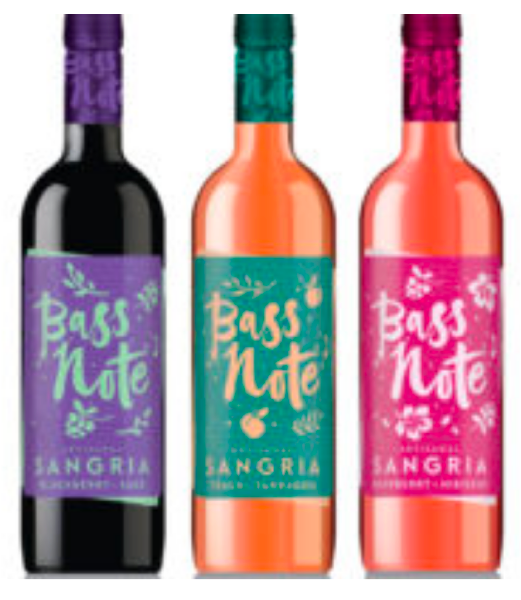 Bass Note Peach Tarragon Sangria 11% alc., $12.99, screw cap. Terrific, intense peach flavor with a hint of herbs. Moderately sweet, with a clean, refreshing attitude. Similar to Pinot Gris infused with peach. Bass Note Blackberry Sage Sangria 11% alc., $11.99, screw cap. Liberal blackberry and blueberry fruit flavor with dried sage in the background. Less sweetness than the Peach Tarragon Sangria and closest in flavor profile to a traditional sangria. Bass Note Cherry Lime Almond Sangria 11% alc., $11.99, screw cap. Too flowery on the nose and palate for my taste. Similar to pumped-up rose water. I could not detect lime or almond flavors.
To The Point
Compilation of Location of Grape Varieties David Morrison, who writes The Wine Gourd at www.winegourdblogspot.com compiled the estimated growing areas in the year 2016 for 300 wine grape varieties in 50 countries. Bearing area of Pinot Noir in 2000 and 2016:
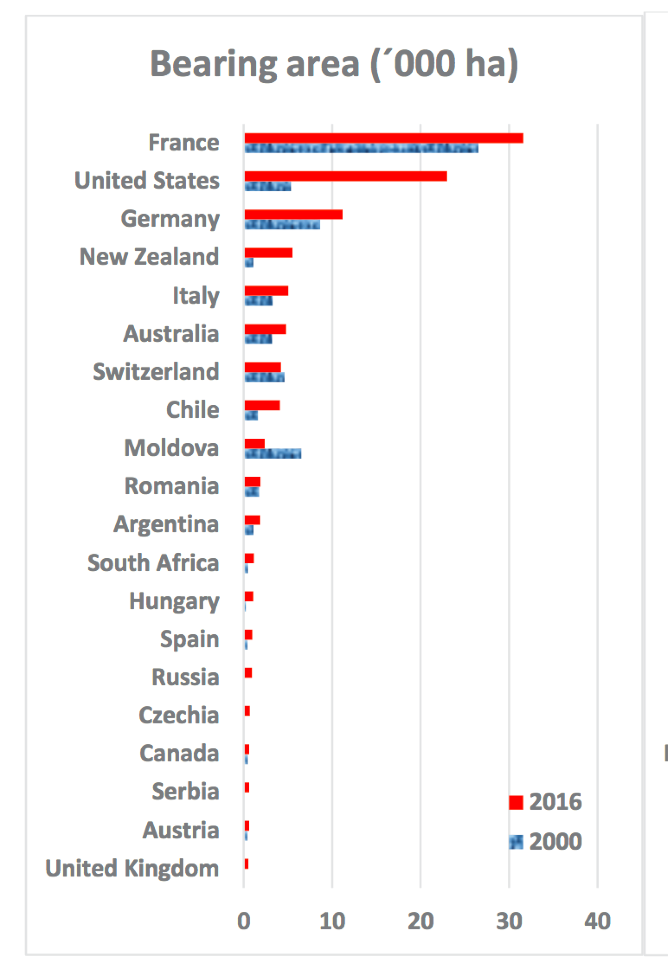 California Pinot Noir Crush by District 2015-2019:
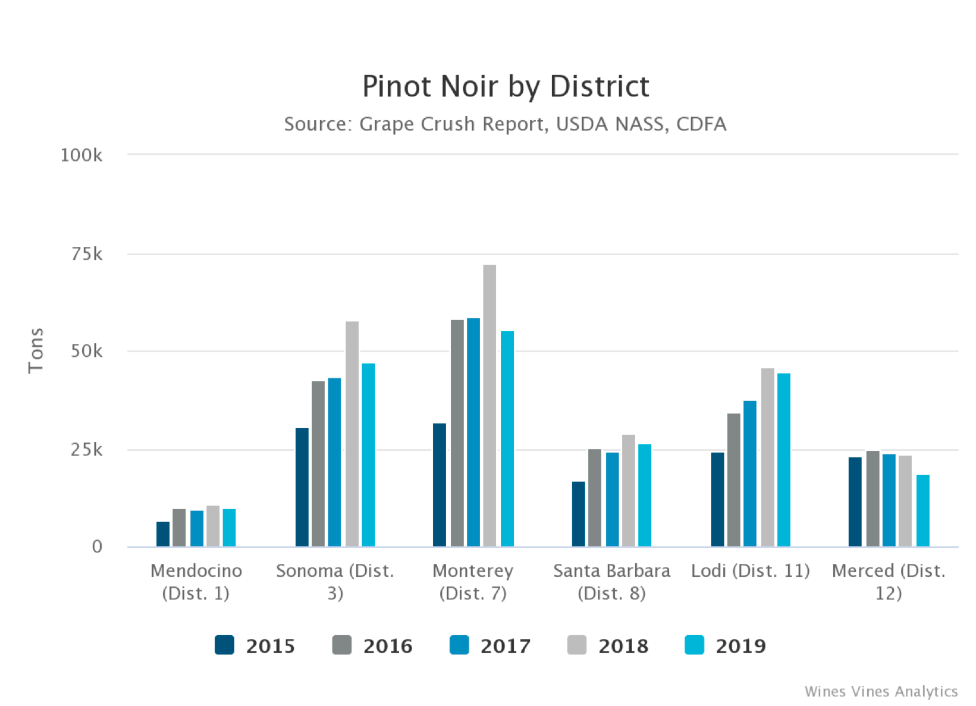 Smoke Taint in 2020 Quotes from Wine Business Monthly. A chief executive of a wine company that buys grapes in Oregon, Washington and California said, “There are winemakers that believe in protocols that they feel they can use to counter a bit of smoke taste. There’s other winemakers who can’t and won’t deal with it. A lot of it ends up being about the mindset of the winemaker. What I’ve seen this year is that they’re all over the beard.” Rick Aldene, North Coast Winegrapes Manager at Agajanian, Inc., “Every vineyard and every varietal that was hanging after August 17 from Mendocino all the way down to San Luis Obispo has a smoke taint number. That is a fact. Not one grower can say ‘I don’t have taint.’ I can tell you, every grower has a taint number now. Some areas are much less affected and the taint numbers are extremely low and completely manageable in the winemaking process.” Ash on Pinot Noir grapes, EMTU Winery, Sonoma County:
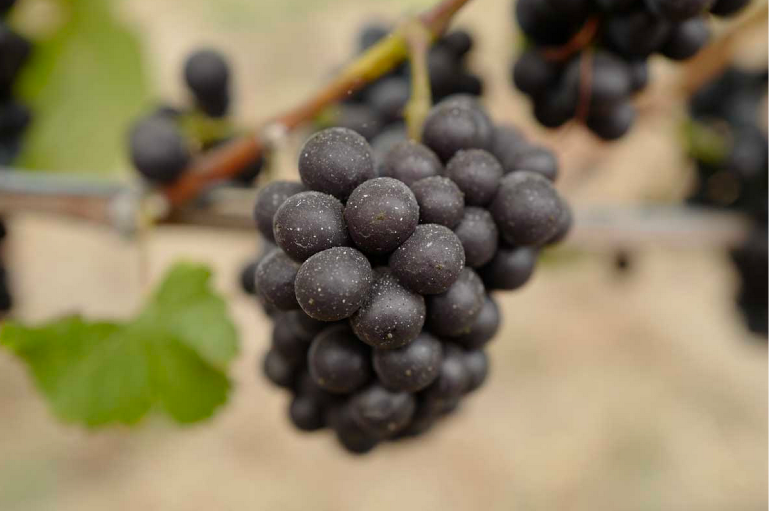 New Book from Michael Browne For Kosta Browne, CIRQ and CHEV wine fans, Michael is releasing an audiobook narrated by William Shatner and a paperback book on November 10, 2020, titled Pinot Rocks - A Winding Journey Through Intense Elegance. Michael shares his journey to success and offers insight and inspiration for those who believe in the American dream and choose to never stop pursuing it. Learn more at www.brownefamilywines.com/book
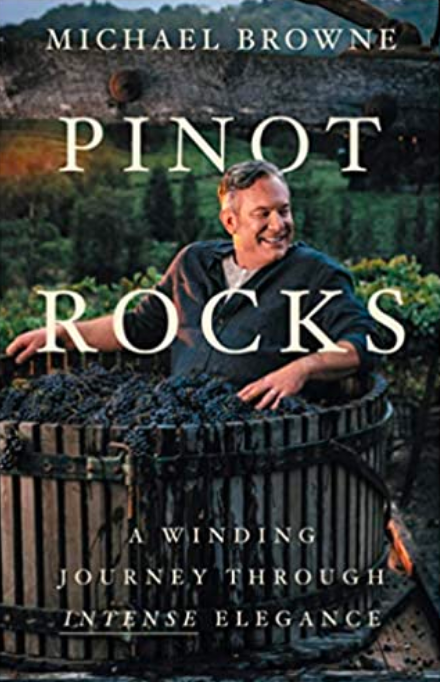 Celebrating Hispanic Roots: ‘Raices Unidas’ Oregon’s first annual Latin heritage celebration was held on October 1, 2020. Two virtual panel discussions (one in English and one in Spanish) included winemakers Ximena Orrego of Atticus Wine, Carla Rodriquez of Beacon Hill Winery and Vineyard, Sofia Torres-McKay of Cramoisi Vineyard and Winery, Cristina Gonzales of Gonzales Wine Company, Sam Parra of PARRA Wine Company and Juan Pablo Valot of Valcan Cellars. Special wine packages were available throughout National Hispanic Heritage Month at www.celebratinghispanicroots.com Climate Change Affecting Wine Harvests Globally Gregory V. Jones, director of the Evenstad Center for Wine Education at Linfield University in McMinnville, Oregon, is not particularly optimistic about the future. “The whiplash is becoming extreme. We have two to three years of drought followed by a year of extreme wet weather, with landslides and mudslides. Modeling shows these whiplashes are going to be prominent in mid-latitude wine regions like Australia, Chile and the western United States. There’s some evidence the western United States is in the beginning stages of an extended mega-drought that could bring 20 years or so of extremely dry weather.” Read more at https://wapo.st/3na4C5I ¡Salud! Online The Oregon Pinot Noir Auction will host its 29th annual celebration virtually November 9-16 to raise funds for healthcare services for Oregon vineyard workers. ¡Salud! is offering COVID-19 screenings, education and support to vineyard workers and their families. ¡Salud! begins Monday, November 8, at 8 a.m. with the Big Board Auction. Three days of bidding on 36 specially made 2019 cuvées with live, winemaker hosted panels daily at 10 a.m. and 2 p.m. Bids can be placed online from anywhere in the country. Friday, November 13 to Monday, November 6, the Live and Silent Auction offers unique wine packages from Oregon and beyond. Saturday, November 14, ¡Salud! hosts a 1-hour live stream gala with special guests and live auction packages. To attend the 2020 ¡Salud! virtually, visit www.saludauction.org
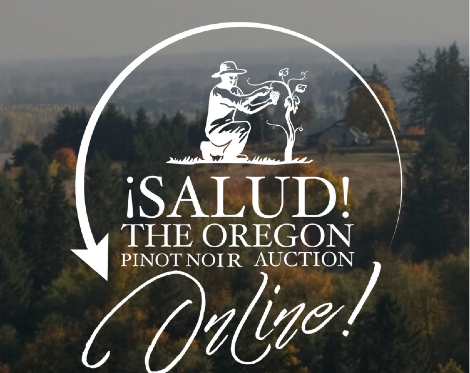 Escalating Wine Prices My impetus for concentrating on domestic Pinot Noir priced under $30 in this issue is the rising prices of desirable domestic Pinot Noir that put these wines out of reach for a majority of consumers. $60-$70 seems to be my resistance point beyond which I won’t buy a domestic Pinot Noir. I quit buying red Burgundies after the 2005 vintage because of the crazy escalation of prices that followed that vintage. This meant I have not tasted or drank any of the world’s great red Burgundies from the last twelve vintages. As the Wine Curmudgeon pointed out in a posting on November 6, 2020, “We’re at a point where people buy the world’s great wines not to drink them, but to keep them in a vault and watch them appreciate in value, using their acquisitions to prove their superiority to the rest of us. How screwed up is that?” Read more: https://www.winecurmudgeon.com/expensive-wine-pricing-and-snobbery-have-been-institutionalizedlegitimized-and-even-admired/ Age Representation in Wine Purchases
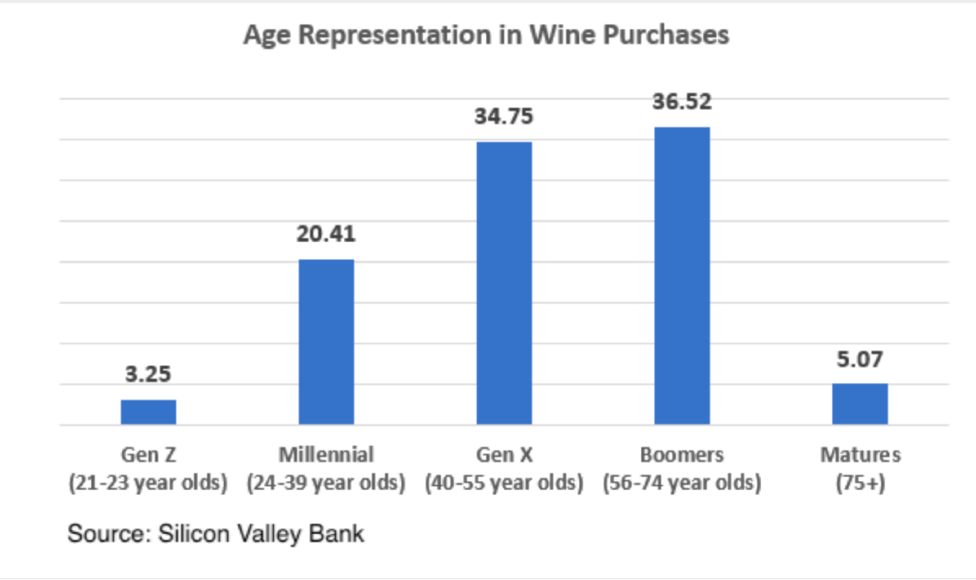
Red Blotch Update
Foundation Plant Services (FPS) at UC Davis has been testing grapevines in its foundation vineyards for GRBV since 2013. A recent report released by FPS Director Deborah Golino showed that red blotch infection rates have remained extremely low in the Classic Foundation Vineyard, ranging from 0% to 0.21% since 2013. None of the 4,270 vines was infected in 2020. Russell Ranch Vineyard (RRV) remained unaffected until 2017 when 5 vines or 0.1% were infected with GRBV. Since then, despite significant efforts to prevent the occurrence of the disease, the infection rate in the vineyard has increased to 7.1% in 2019 and 18% in 2020 (see table). The incidence of red blotch at RRV is due to field transmission of GRBV. All propagated vines related to the positive vines tested negative in every case. In 2018, a test-to-order policy was instituted to further ensure orders being shipped were negative prior to distribution. One of the greatest challenges in managing red blotch has been vector-mediated transmission. The three-cornered alfalfa hopper has been documented as a vector in greenhouse studies and has been found in RRV. FPS has implemented more frequent vineyard inspections and additional spray treatments targeting the vector and has developed a comprehensive program for control of this vector. Despite those precautions, there remains a risk of other unknown vectors transmitting red blotch. FPS has discontinued distributing material from RRV because of the level of red blotch infection. Grapevine material from the Classic Foundation Vineyard will continue to be available for distribution and is tested for GRBV as dormant canes prior to shipping. FPS is designing a 24,000 square foot ‘Emergency Greenhouse’ that will protect approximately 4,000 of FPS’ most valued Foundation grapevines. This will protect the material from vectors and guarantees immediate access to the clean plant material in case of field infection.
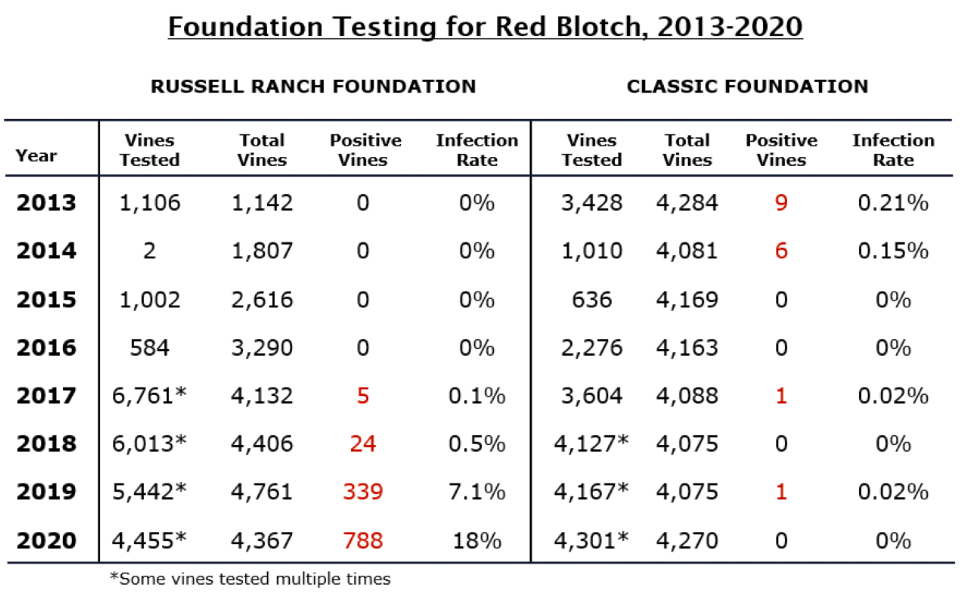
Prince is “Semi-Retired”
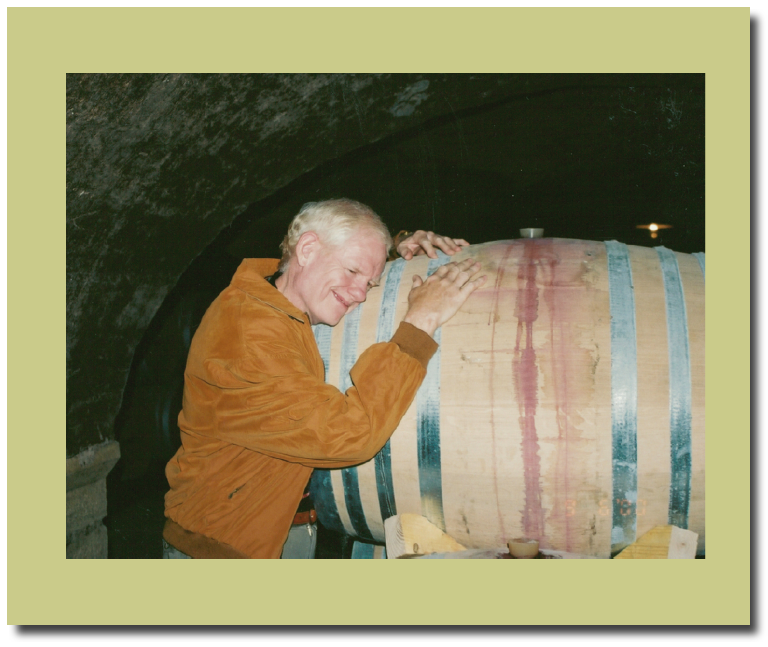 I “retired” on August 1, 2019, after publishing the PinotFile for 18+ years. I had become overwhelmed by the increasing number of wines submitted for review. I wanted to slow down and spend more time drinking rather than critically tasting Pinot Noir. In early 2020, failing to find someone suitable to take over the PinotFile, still inspired by my interest in Pinot Noir and spurred on by readers’ encouragement, I began composing less frequent issues of the PinotFile that included specially focused subjects of special interest to me written in detail, along with reviews of Pinot Noir wines submitted by wineries that did not realize I had “retired,” and reviews of Pinot Noir wines that stood out to me that I had drunk. Now I am “semi-retired”, work at a leisurely pace, and accept a limited number of Pinot Noir wines for review only by invitation. This has caused some confusion among wineries wishing to submit their wines for review since I continue to review some wines. If an interested winery emails me an inquiry (princeofpinot@gmail.com), I will let them know if and when a window for wine submission arises. I only review Pinot Noir now. |